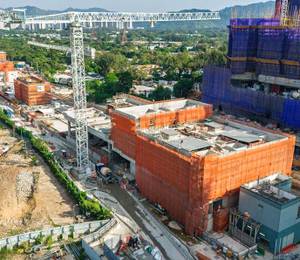Snorkel has commenced full production of five lithium-ion battery powered compact rough-terrain scissor lift models. They include lithium-ion battery versions of two narrow width units, the S2255RTE and S2755RTE, as well as three standard width units, the S2770RTE, S3370RTE and S3970RTE.
Available for delivery globally, these five ‘RTE’ electric scissor lifts are being manufactured at Snorkel’s assembly facilities in the UK and New Zealand. The machines expand the company’s lithium-powered range of zero emission rough-terrain aerial lifts and telehandlers to a total of eight models. They join the Snorkel SL26RTE and SL30RTE electric Speed Level launched in 2019, and the Snorkel SR5719E/SR626E electric compact rough-terrain telehandler launched in 2020.
The five new scissor lifts are equipped with maintenance-free lithium-ion battery packs with built-in battery management systems (BMS), which last up to 20 times longer than lead acid batteries, said Snorkel. Suitable for most environments, the lithium-ion battery packs have been tested in climatic chambers between -25°C and 60°C.
Snorkel shared that in both test conditions and real-life applications, the standard two battery pack system has been proven to deliver at least an eight-hour shift on a single charge, and in some cases, up to one week between charges, subject to usage. Unlike lead acid batteries, the charging pattern for lithium-ion batteries is designed to seamlessly fit into a normal working day schedule and can be top-up charged during breaks and shift changes.
The five Snorkel models are offered as standard with two 5.75-kWh lithium battery packs, and can be optioned with an additional 5.75-kWh battery pack for extended range for very heavy-use applications or where long-distance driving is required.
Designed for outdoor applications, a powerful and efficient AC electric motor creates efficiencies in the hydraulic drive system with higher torque than a diesel engine, which in turn provides improved gradeability and enhanced performance on rough terrain than traditional combustion scissor lifts.
The electric motor delivers up to 62% less jobsite noise than the diesel equivalent, revealed Snorkel, which enables the lifts to be used indoors or in work environments with noise regulations. Having no engine fan, dust generation is also reduced for safer and cleaner operation in low-emission zones and green cities.
What’s more, with minimal battery and electrical system maintenance required, servicing costs are reduced by up to 93% when compared to an engine, while also eliminating the costs and risks of waste oil and filter disposal.
“We are delighted to extend our proven lithium-ion battery solution to these five popular compact rough-terrain scissor lift models. Within the past two years, we have developed and fully released eight electric zero emission models with four-wheel drive capabilities, with more to come,” said Matthew Elvin, CEO of Snorkel.
“We understand that our customers need robust, reliable and easily adopted products that help them achieve their net zero goals without compromising on performance, and are proud to offer these innovative lifts which deliver on all fronts.”
The Snorkel S2255RTE and S2755RTE can reach maximum working heights of 8.5 m and 10.1 m and offer lifting capacities of 420 kg and 300 kg respectively. Popular for their narrow width of just 1.45 m, these lifts feature a spacious 1.4 m x 3.93 m platform with the 1.2 m roll-out deck extension deployed. Weighing less than 2,750 kg, the machines can be towed by a car or light commercial vehicle on a trailer between jobs.
Measuring 1.8 m wide, the S2770RTE can lift up to 580 kg to a maximum working height of 10.1 m, while the S3370RTE can lift 454 kg to a working height of up to 12 m. Reaching up to 13.8 m, the S3970RTE is the largest compact rough-terrain scissor lift in the family and is capable of lifting up to 350 kg.
All five lifts are available with high grip, non-marking tyres for indoor/outdoor use, and have four-wheel drive capabilities with 35% gradeability and an oscillating axle. Four auto-levelling stabilisers come as standard, which benefit from Snorkel’s inverted leg design that protects the cylinder rod from damage and debris, and can level up to 6 degrees front-to-rear, and 10 degrees side-to-side.
According to Snorkel, these same models also continue to be offered as ‘RT’ versions with a diesel engine or as ‘BE’ versions with Snorkel’s innovative bi-energy solution that enables the operator to switch between an internal combustion engine and lead acid battery power for indoor/outdoor working.















